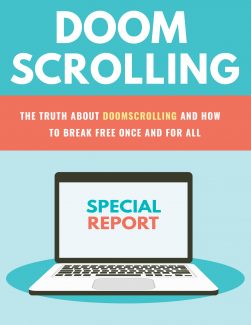 License Type: Private Label Rights
License Type: Private Label Rights  File Type: ZIP
File Type: ZIP
 SKU: 63971
SKU: 63971  Shipping: Online Download
Shipping: Online Download
Sample Content Preview
Introduction
Many of us are familiar with this routine.
You log onto your favorite social media platform and check the COVID-19 reports, then move on to the state of the economy, and climate change, finally ending with the latest debacle created by that politician who pushes all your buttons.
Let’s not forget the latest school shootings and the gun control debate, the healthcare chaos, and the attacks on democracy.
And that’s just the local news.
What about the Middle Eastern wars, Russian cyber-attacks, and Australian wildfires?
There seems to be no end to the catastrophic news scrolling across our screen.
Bad news has always been around, of course. But why is it having such an impact on our mental health lately—and what can we do about it?
Let’s take a good, hard look at the practice of doomscrolling (otherwise called doomsurfing), how it may be impacting your mental health, and what you can do to replace this negative habit with positive, fulfilling ones that improve the quality of your life.
Let’s begin!
The Truth About Doomscrolling
Doomscrolling is the obsessive intake of bad news, even when it creates anxiety and worry. Despite knowing how it makes you feel, you just can’t seem to stop yourself from consuming this toxic information.
Finance reporter Karen Ho originally discovered the term on Twitter, and it turns out that there are good reasons why we are so likely to fall into the destructive habit.
Media psychologist Pamela Rutledge explains: “The tendency to doomscroll is a result of how the human brain is wired. Our brains instinctively pay attention to any potentially dangerous situation as part of the biological imperative of survival. Our brains are designed to constantly scan the horizon for potential threats. Since threats are more important to our survival than other information, we pay more attention to the negative information than to the positive. When there are no answers or conflicting answers, more information doesn’t increase our sense of safety, so we scroll in pursuit of better answers, and so on.”
It’s a seemingly never-ending cycle of negativity and unhappiness.
Mike Brooks, co-author of Tech Generation: has this to say about doomscrolling. “Fifty thousand years ago, when we were on a savannah, if we missed the bad news that there was a pride of lions stalking a watering hole, we could have been eaten. But if we missed the good news that a tree nearby was bearing fruit, we likely would have lived to see another day.”
So, if you’ve been consumed by doomscrolling, don’t feel bad. You’re certainly not alone. It’s human nature to pay attention to new information, especially if that information might help us respond to danger and ultimately, survive.
But the truth is, in today’s times, doomscrolling isn’t just unhealthy, it can lead to missed deadlines, incomplete tasks, and cost you valuable time that should be spent with friends and family.
The habit also isn’t an easy one to break, especially if you have a mobile device and are used to consuming news throughout the day via apps or favorite websites.
But thankfully, there are things you can do to quickly replace this toxic habit with ones that will add value to your life, and improve your mindset.
Before we get to that, let’s take a closer look at how doomscrolling may be impacting your daily life in ways you may not even be aware of.
How Doomscrolling Impacts Our Lives
Your brain responds to negative information by activating your “lizard brain”, particularly a structure called your amygdala, a collection of cells near the base of your brain.
This sets off your natural response to danger in your environment. You become hyper-vigilant and start scanning the terrain for threats.
In other words, you’re on high-alert and your mind and body are laser focused on potential harmful situations that may arise.
Your limbic system switches into fight-or-flight mode and sharpens your reaction times in an effort to save your life. Your pulse spikes, your body may grow stiff, and you aren’t able to relax.
“The part of our brain that governs doomscrolling is ancient,” says Dr. Aditi Nerurkar, a Harvard physician. “It’s an adaptive response to stress, meaning our species has learned to keep going and thrive and survive. Scanning for danger, looking around, making sure we’re all OK; that is a normal and healthy response to stress.”
But if you combine that evolutionary affinity for bad news with the marketing tactics that social media companies use to keep you hooked on their content, doomscrolling seems nearly inevitable.
Larry Rosen, co-author of The Distracted Mind: Ancient Brains in a High-Tech World, explains it this way:
“The problem is that tech companies have set up a system where you feel that you can’t stop: infinite scrolling, auto-play, and other tricks keep you glued to the screen. If you find a doom-and-gloom article online, and you want to continue in that vein, it’s hard to stop because there’s always more, and you don’t want to miss out.”
- License: Private Label Rights
- Category:Ebooks
- Tags:2021 Ebooks Private Label Rights








